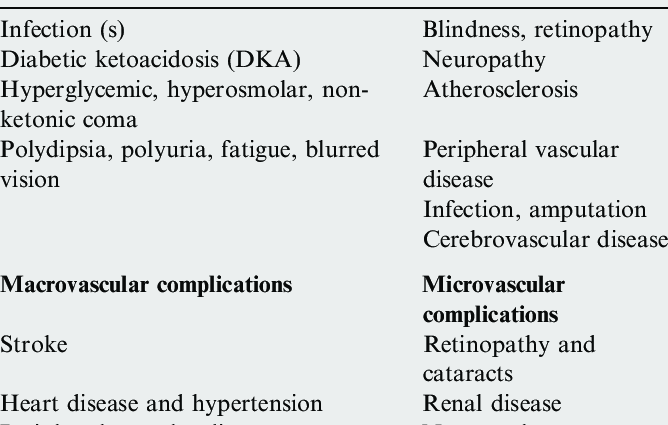Complications of diabetes
The complications associated with long-term diabetes afflict a significant proportion of diabetics: about 4 in 10 suffer from it, regardless of the type of diabetes.
A rate of glucose too high blood (or blood sugar), even periodically, can cause serious health problems over time.
The earlier diabetes appears in life, the greater the risk of complications. However, it is quite possible to retarder or prevent the majority of complications by strict control of blood sugar.
Undiagnosed or poorly controlled diabetes can also lead to severe acute complications, which are medical emergencies.
Acute complications of diabetes Diabetic ketoacidosis This is a condition that can be fatal. When the body lacks insulin, it replaces glucose with another fuel: fatty acids. This produces ketone bodies which in turn increase the body’s acidity. Symptoms : fruity breath, dehydration, nausea, vomiting and abdominal pain. If no one intervenes, difficult breathing, confusion, coma, and death can occur. How to detect it: high blood sugar, most often around 20 mmol / l (360 mg / dl) and sometimes more. What to do : if ketoacidosis is detected, go to a hospital emergency department and contact your doctor afterwards to adjust the medication. Hyperosmolar state When type 2 diabetes is left untreated, hyperglycemic hyperosmolar syndrome can develop. This is a real medical emergency which is fatal in more than 50% of cases. Symptoms : increased urination, intense thirst and other symptoms of dehydration (weight loss, loss of skin elasticity, dry mucous membranes, increased heart rate and low blood pressure). How to detect it: blood sugar that exceeds 33 mmol / l (600 mg / dl). What to do : if a hyperosmolar state is detected, go to the emergency department of a hospital and contact your doctor afterwards in order to adjust the medication. |
Long-term complications
Almost any part of the body can be affected by poorly controlled diabetes : heart, blood vessels, kidneys, eyes, nervous system, etc. As many organs can be affected because, over time, thehyperglycemia weakens the walls of the small blood vessels that supply all tissues with oxygen and nutrients.
Eye disorders. Diabetes can lead to a gradual deterioration of vision. It can also lead to the formation of cataracts and glaucoma, even to loss of sight. Eye disorders are the most common complication of diabetes. Almost all people with type 1 diabetes develop it, while it affects 60% of type 2 diabetics. retina is the part of the eye most often affected, but other parts can be affected as well.
neuropathy. Neuropathy is the name given to conditions that affect the nerves and which can be quite painful regardless of the cause. It forms in the first 10 years of diabetes in 40% to 50% of people with type 1 or 2 diabetes. Neuropathy results from poor blood circulation (therefore an insufficient supply of oxygen for the nerves) and a high level of glucose which alters the structure of the nerves. Most often, the subject feels tingling, loss of sensitivity and pain which first appear at the tips of the toes or fingers, then gradually move up along the affected limbs. Neuropathy can also affect the nerves that control digestion, blood pressure, heart rate, sex organs, and the bladder.
Susceptibility to infections. The rise in blood sugar and the fatigue sometimes caused by the disease make people with diabetes more at risk ofinfections periodic sometimes difficult to cure. These can be infections of the skin, gums, respiratory tract, vagina or bladder. In addition, diabetes can slow down the process of healing, which can cause recalcitrant infections in wounds. Foot infections are the most common. Partly due to neuropathy, they may be accompanied byulcers, and sometimes even require the amputation of the foot in case of gangrene.
Nephropathy. The term nephropathy comes from the Greek nephros = kidney. Kidney tissue is made up of a multitude of tiny blood vessels that form a filter whose role is to remove toxins and wastes from the blood. As diabetes causes vascular disorders, the small vessels of the kidneys can be affected to the point of causing progressive deterioration of the kidneys which will manifest itself in a variety of problems, ranging from kidney failure to irreversible kidney disease. Note that hypertension is also considerably involved in nephropathy.
Cardiovascular illnesses. Diabetes contributes to the emergence of cardiovascular disease. They are 2 to 4 times more frequent in diabetics than in the general population. A high level of glucose in the blood contributes to blood clotting. Over time, the risk of blockage of blood vessels near the heart (heart attack) or in the brain (stroke) increases. THE’age, L ‘heredity, L ‘hypertension, L ‘overweight and tabagisme also increase the risks. Type 2 diabetics often have a profile that initially makes them more at risk for this type of disease.
On average, people with type 2 diabetes will die 5 to 10 years earlier than those without diabetes. This is mostly attributable to cardiovascular disease.










